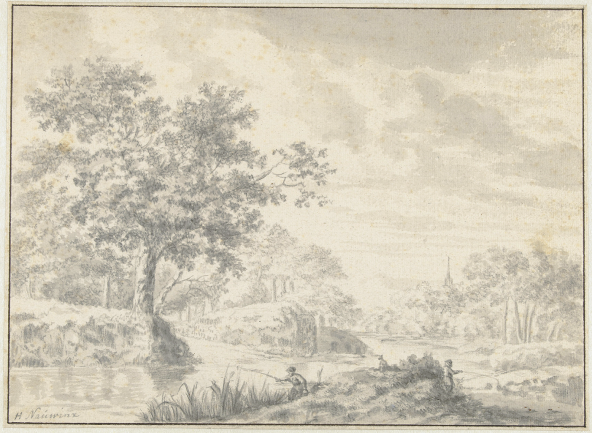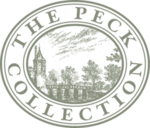Choose a background colour
Attributed to Herman Naiwincx, Dutch, 1623-after 1651
:
Knoll Above a Pond, c. 1640-50
Gray wash over black chalk on paper; framing lines in brown ink.
4 9⁄16 × 7 1⁄2 in. (11.6 × 19.1 cm)
None.
- Chain Lines:
- Vertical, 24 – 26 mm.
- Watermark:
- Fragment of Arms of Orange-Nassau, showing top half only. Similar to Laurentius & Laurentius, vol. 1, nos. 197 – 98; and Heawood, no. 606.
- Provenance:
Dealer, Antiquariaat J. den Hertogh, Zeist, 1963; Hans van Leeuwen, 1911 – 2010, Amerongen (Lugt 2799a, stamp on verso); his sale, Christie’s, Amsterdam, 24 November 1992, lot 145 (as attributed to Herman Naiwincx); Sheldon and Leena Peck, Boston (Lugt 3847); gift to the Ackland Art Museum, inv. no. 2017.1.57.
- Literature/Exhibitions:
F. Robinson in Chapel Hill, Ithaca & Worcester 1999 – 2001, 74 – 75, no. 21.
- Ackland Catalogue:
- 2017.1.57
In this understated yet captivating drawing, dappled light falls on a gently sloping hill beside a tranquil pond. Above the stone retaining wall, a fragment of a wooden fence leads toward a farm, just visible in the upper right. The artist’s subtle use of wash, applied with varying strokes and stippling, provides a richly textured environment while the low viewpoint conveys a sense of immediacy, as though the viewer is actually standing in the artist’s place.
This is possibly a rare work by the talented but little-known painter, Herman Naiwincx, whose known body of drawings numbers around two dozen sheets.1
The Peck drawing is not mentioned in the few previous publications devoted to the artist, having only come to light more recently. Naiwincx was a landscape specialist, whose paintings often feature mountains and craggy rocks in an Italianate manner. He seems to have been under the spell of his Dutch Italianate contemporaries such as Jan Asselijn (1610 – 1652), Jan Both (1615/22 – 1652), and Nicolaes Berchem (1621/22 – 1683). Sometimes in his prints and drawings he created equally pleasing lowland views of woods and rivers that ostensibly proffer local Dutch settings rather than Alpine or Italianate ones.2
Featuring a rich set of textures, this drawing focuses on what appears to be a marshy area on a farm (just visible in the background on the right). The fence probably served to help livestock avoid the slightly precipitous drop in front of the stone retaining wall. Naiwincx frequently found artistic potential in the intersection of land, vegetation, and water, especially in his drawings. Such a combination requires a command of a range of strokes, seen here particularly well in the intermingling of elements along the embankment and in the convincing reflections in the pond. A comparable example in Naiwincx’s oeuvre can be found in the Rijksmuseum Fig. 34.1.3

Herman Naiwincx, Wooded River Landscape with Two Anglers, c. 1634 – 54. Gray wash and black chalk, 196 × 269 mm. Amsterdam, Rijksmuseum, inv. no. rp-t1898-a-3520.
Rijksmuseum, Amsterdam
The compact and unusually low viewpoint in the Peck drawing, as well as the greater reliance on brushwork alone, might reflect his further development as an artist. Other drawings by Naiwincx that evince similarities with the present sheet can be found in the British Museum, London, and the Fondation Custodia, Paris.4
Only a few of his securely attributed works, however, match exactly in style. Ultimately, the attribution of the unsigned Peck drawing to Naiwincx, while entirely plausible, remains somewhat tentative.
None of Naiwincx’s works bear dates within his relatively small oeuvre of paintings, drawings, and prints.5
He only appears in documents as an adult between 1648 and 1651, and he may have either died young or abandoned his artistic activities after a certain point.6
The latter is certainly a possibility since he described himself as a merchant (coopman) in some of those documents.7
We also know that he belonged to a family that ran a major tapestry-making business based in Schoonhoven. One indication of its scale and success is that they rented a large number of tapestries to the city of Amsterdam for the arrival of Marie de’ Medici in 1642.8
Naiwincx’s pursuit of art as a landscape specialist would not be out of line with such a business. Some of his firm’s tapestries, for example, illustrated tales from Ovid set in wooded surroundings.9
Even if he worked for the family business, he was more than just an amateur, since he named his occupation as painter (schilder) on at least one occasion, and he possibly thought of himself as having dual professions.10
There is also evidence that his paintings could fetch high prices during his lifetime.11
When he was last documented in 1651, Naiwincx was apparently in Hamburg, the hometown of his mother, and it is unclear if he ever returned to the Netherlands.12
Given his eclecticism, modern style of draftsmanship, and evidence that he once produced considerably more works than have survived or come to light, it is entirely possible that he survived the trip and continued to be active as an artist after this date.
End Notes
For Naiwincx’s drawings, see Blankert & Nystad 1979, 55 – 58, cataloguing seventeen works (and rejecting twelve); and Kuyper 1984, supplementing their catalogue with two additions. Others have come to light, though sometimes with contested attributions; see, for example, Sadkov 2010, no. 285 (rejected by P. Schatborn); and sale, Christie’s, Amsterdam, 10 December 2014 (I. Q. van Regteren Altena Collection, Part II), lot 244 (appears autograph). Several drawings by or attributed to Naiwincx in Berlin were apparently overlooked by Blankert & Nystad, for which see Bock & Rosenberg 1930, vol. 1, 198 (six drawings accepted, three as questionable).
For Naiwincx’s etchings, see Hollstein, vol. 14, 132 – 35, nos. 1 – 18; and The Illustrated Bartsch, vol. 5, 99 – 106, nos. 1 – 16.
Blankert & Nystad 1979, 55 – 56, no. T5.
Blankert & Nystad 1979, 55, nos. T3, T4. For the British Museum drawing, see also Hind 1915 – 32, vol. 4, 3, no. 3; and for the Fondation Custodia drawing, see Brussels, Rotterdam, Paris & Bern 1968 – 69, vol. 1, 109 – 10, no. 107, vol. 2, pl. 132.
See the remarks in Kuyper 1984, 240 – 41.
For biographical summaries, see Blankert & Nystad 1979, 48 – 49; C. Schuckman in Turner 1996; and I. Veldman in the Allgemeines Künstlerlexicon
See Schaap 1956 for a history of the tapestry firm; and idem, 6, for the rental to the city of Amsterdam.
Schaap 1956, 2; destroyed during the 1929 fire in the Leiden town hall.
For the mention as painter, see Dudok van Heel 1994, 346 (note 28): “Herman Nauwinghs, schilder, in de Warmoesstraedt in ‘t Waapen van den Briel, jongh man” (23 June 1650).
See Bredius 1941, 22, mentioning a certain Josias Tullekens, who purchased a landscape by Naiwincx for f 50.
Blankert & Nystad 1979, 48 – 49.
